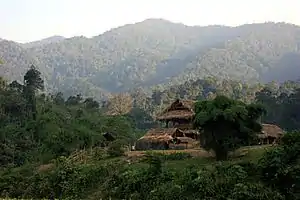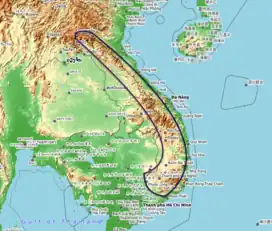Annamite Range
The Annamite Range or the Annamese Mountains (French: Chaîne annamitique; Lao: ພູ ຫລວງ Phou Luang; Vietnamese: Dãy (núi) Trường Sơn) is a major mountain range of eastern Indochina, extending approximately 1,100 km (680 mi) through Laos, Vietnam, and a small area in northeast Cambodia. The mountain range is also referred to variously as Annamese Range, Annamese Mountains, Annamese Cordillera, Annamite Mountains and Annamite Cordillera. The name "Annam" is the Vietnamese pronunciation and terminology of Chinese: 安南 (Pinyin: Ān Nán), meaning "the tranquil south" referring to Vietnam. The French adopted the word and used "Annamese" or "Annamite" to refer to the Vietnamese.
| Annamite Range | |
|---|---|
| ພູຫລວງ Dãy Trường Sơn | |
 Annamite Range in Pu Mat National Park, Vietnam | |
| Highest point | |
| Peak | Phou Bia |
| Elevation | 2,819 m (9,249 ft) |
| Listing | |
| Coordinates | 18°35′30″N 103°48′0″E |
| Dimensions | |
| Length | 1,100 km (680 mi) |
| Width | 130 km (81 mi) |
| Geography | |

| |
| Countries | Laos, Vietnam and Cambodia |
| Geology | |
| Age of rock | Triassic |


The highest points of the range are the 2,819 m (9,249 ft)-high Phou Bia, the 2,720 m (8,920 ft)-high Phu Xai Lai Leng and the 2,598 m (8,524 ft)-high Ngọc Linh (Ngoc Pan). The latter is located at the northwestern edge of the Triassic Kontum Massif in central Vietnam.[1] Important mountain passes are the Nape Pass and the Mụ Giạ Pass.
The Annamite Range runs parallel to the Vietnamese coast, in a gentle curve which divides the basin of the Mekong River from Vietnam's narrow coastal plain along the South China Sea. Most of the crests are on the Laotian side. The eastern slope of the range rises steeply from the plain, drained by numerous short rivers. The western slope is more gentle, forming significant plateaus before descending to the banks of the Mekong. The range itself has three main plateaus, from north to south: Phouane Plateau, Nakai Plateau and Bolaven Plateau.
Laos lies mostly within the Mekong basin, west of the divide, although most of Houaphan Province and a portion of Xiangkhoang Province (where the famous Plain of Jars is located) lie east of the divide. Most of Vietnam lies east of the divide, although Vietnam's Tây Nguyên (Central Highlands) region lies west of the divide, in the Mekong basin.
Ecology
The Annamite mountains form an important tropical seasonal forest global ecoregion, the Annamite Range Moist Forests Ecoregion, which consists of two terrestrial ecoregions, the Southern Annamites montane rain forests and the Northern Annamites rain forests.[2]
The range is home to rare creatures such as the recently discovered Annamite rabbit and the antelope-like saola, the Douc langur, the large gaur, the Chinese pangolin, and the Indochinese tiger.
History
Most of the highlands like the Annamite Range and the Central Highlands were populated by ethnic minorities who were not Vietnamese during the beginning of the 20th century. The demographics were drastically transformed with the mass colonization of 6 million settlers from 1976 to the 1990s, which led to ethnic Vietnamese Kinh outnumbering the native ethnic groups in the highlands.
See also
References
- Southern Annamites montane rain forests Archived October 1, 2010, at the Wayback Machine
- "WWF - Annamite Range Moist Forests". Archived from the original on 2017-08-08. Retrieved 2012-02-21.